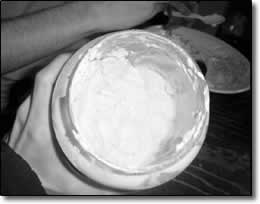
Mayonessa grace
by Chef Boy Ari

Three weeks into my fourth trip to Brazil, my love for this country continues to grow. As does my belly. There is a Brazilian expression, "demais," that describes Brazil perfectly. It means something like "too much" but in a positive sense. Brazil is everything to the max. The landscape is a kaleidoscope of shapes and colors. So are the people, who have a tendency to be extremely friendly, positive, happy and relaxed. The language has more words for shaking your "boom-boom" than Eskimos have for snow, and the music is beyond "demais." All things considered, it should be no surprise that the food is "demais" as well.
Consider the Brazilian approach to mayonnaise: squirt bottles everywhere. People use these bottles to improve their sandwiches, pizzas, salads and most other things worth putting in your mouth. And like most other things, Brazilians have taken their "mayonesssa" to the max. Not only is "mayonessa" a popular condiment, it's also a popular dish. But before you get too impressed (or grossed out), let me explain that the "mayonessa" dish of which I speak is nothing more than the dish that we in the North call "potato salad." Nonetheless, there is an important story mixed in with those creamy chunks.
The reason I'm here in Brazil, by the way, is to lead a group of students on a study tour of Brazilian alternative agriculture communities.
At one such community, a place called Lothlorien in the gorgeous valley of Capao, all the food was meat- and egg-free. Many people in my group, accustomed to the meaty diet of the Rocky Mountains, were apprehensive about the possibility of flavor and protein deficiencies. I, meanwhile, was bracing for mayo withdrawal. All of these concerns turned out to be for naught.
Breakfast was a buffet of tropical fruit laid out on banana leaves, served with homemade granola, homemade yogurt and homemade molasses followed by hot baked goodies. Lunch was always big, with main dishes, a large selection of cooked veggies, a huge salad and a sweet dessert. Dinner was usually a hearty pot of soup served with a side dish or two.
The food was simple yet potent, and I learned several nuggets of culinary wisdom that I will take with me always. For example: starting a meal with "alho muchado" on a hot pan.
"Alho muchado" means mashed garlic. Geu, the head cook, used a big wooden mortar and pestle to mash the garlic, and then she would mix it with a little salt. When preparing almost anything, from squash soup to stir-fry, Geu would start with a dollop of muchado" on a bare pan - no oil! - over medium heat. She would proceed to smear this pungent paste into the bottom of the pan, and then scrape it off and re-smear it, over and over again, until it was a toasted shade of gold. Then she would add whatever else she was cooking with some water, and eventually some oil, and it would be "demais." And that smell when the "alho muchado" first hits the dry pan. Even from miles away, it could wake me out of the deepest coma.
My carnivores were quickly pacified by Geu's vegetarian virtuosity. I, too, was pacified, especially when she prepared a "mayonessa" (the dish) using a homemade "mayonessa" (the sauce) that didn't contain eggs. Carrots were used in place of eggs, and some might argue that calling this mayonnaise is like eating Tofurky for Thanksgiving. I can sympathize with that kind of Puritanism. I think "Nayonnaise" is gross. Tofurky offends me. But for the moment, let's put this question aside.
To make carrot mayonnaise, steam five medium carrots until they are well cooked and let them cool to room temperature. Meanwhile, peel several cloves of garlic and add them to a blender with a tablespoon of oregano, a half-teaspoon of salt and one cup of oil. I recommend a blend of oils, my personal favorite being half olive oil and half sunflower oil. Other good candidates are grapeseed, canola, safflower or even toasted sesame oil. After these ingredients are all blended together, add the soft carrots one by one, letting each carrot liquefy before adding the next.
With each carrot, the mix will thicken. Keep adding carrots until it's too thick to blend. Voila! To use your carrot mayonnaise to make a "mayonessa," dice and steam some potatoes, let them cool and mix them with chopped green onions and chopped parsley. Then mix in the carrot mayonnaise.
This is what Geu did, and it was very good. My subsequent research has uncovered many more wonderful uses for this orange puree that looks like baby food but tastes like manna from heaven. You can dip crackers into it, as you would hummus. It's great served on top of pasta, rubbed on meat ... You can spread it on sandwiches or just stick your finger in it and eat it.
"Demais!"
So maybe it is fair to call this stuff mayonnaise after all, because it's good on everything!
|